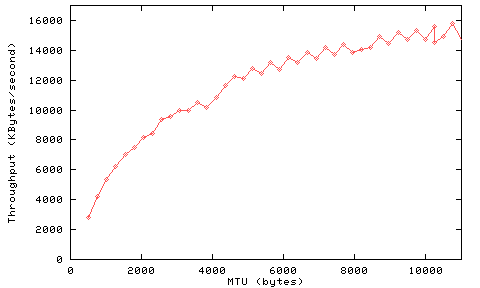Effects of MTU
The packet size used by TCP, often called Maximum Transmission Unit
(MTU), effects efficiency in at least two conflicting ways. The host
interfaces interrupt on each packet, and a good deal of TCP processing
time is per packet (not per byte), so the hosts can send and receive
faster with larger packets. On the other hand, TCP works best if it
can keep a window of at least four packets in flight, since it detects
a dropped packet by noting acknowledgments prompted by the rest of the
packets in the window. Since the propagation delays are all small in
these experiments, the packets in the window can only be stored in
host and switch buffers. In many of these experiments the switch
buffering will be limited to a few hundred 53-byte cells per VC, so
packet sizes much larger than 2K bytes cannot be expected to work
well.
This graph shows the effects of MTU on a single TCP connection through
the switch. Since there is no congestion, switch buffering is not an
issue. The only factor involved is the host's efficiency at processing
packets.

Large MTUs approaching 10K bytes allow the hosts to use TCP at close
to the network limit of 17 megabytes/second. Note that with an MTU of
2304 bytes, a single TCP connection can make use of half the link
bandwidth. This will be important for the rest of the experiments, in
which two TCP connections compete for the link bandwidth.

